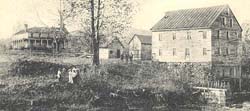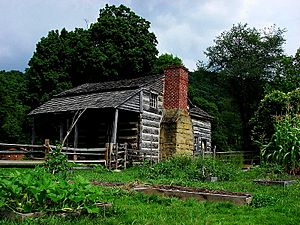Jackson's Mill facts for kids
|
Jackson's Mill
|
|
|
U.S. Historic district
Contributing property |
|

Tom's Mill, owned by Cummins Jackson
|
|
| Nearest city | Weston, WV |
|---|---|
| Built | 1837 |
| Part of | Tom's Mill State 4-H Camp Historic District (ID04001598) |
| NRHP reference No. | 72001289 |
Quick facts for kids Significant dates |
|
| Added to NRHP | February 23, 1972 |
| Designated CP | February 4, 2005 |
Jackson's Mill is a historic place in Lewis County, West Virginia. It was once a busy grist mill, which grinds grain into flour. Today, it is a museum property owned by the state of West Virginia.
Jackson's Mill is special for two main reasons. First, it is a very old and well-preserved grist mill. Second, it was the childhood home of Stonewall Jackson. He became a famous general during the American Civil War. The mill was added to the National Register of Historic Places in 1972.
Contents
Discover Jackson's Mill: A Historic Place
Jackson's Mill sits on a piece of land shaped like a finger. This land is where Freeman's Creek meets the West Fork River. Edward Jackson, Stonewall Jackson's grandfather, built a home here. It was a two-story log house. In 1809, he also built a sawmill and a grist mill on the other side of the river.
What Does the Mill Look Like?
The mill you see today is a three-story building made of wood. It has a wooden shingle roof. The outside is covered with weatherboard siding. Inside, much of the original wood and machinery is still there. You can see large cog wheels that helped the mill work. Some parts, like the floor, have been replaced. New oak wood was used to match the original look. You can also see an old millstone and a feed hopper on the second floor. These were used to grind grain.
Stonewall Jackson's Boyhood Home
After Edward Jackson passed away, his son Cummins Jackson took over the mill. Cummins was Stonewall Jackson's uncle. Stonewall Jackson's birth name was Thomas Jonathan Jackson.
Young Thomas's Life at the Mill
Thomas's father, Jonathan Jackson, died in 1826. His mother, Julia Neale Jackson, struggled to care for him and his sister, Laura Ann. In 1830, when Thomas was six, he and Laura Ann went to live with their uncle Cummins. Their mother passed away the next year. This left Thomas and Laura Ann as orphans, depending on their uncle.
Young Thomas worked hard on his uncle's farm. He helped tend sheep with a sheep dog. He also drove teams of oxen. He helped harvest wheat and corn. Formal schooling was not always easy to get. But Thomas went to school whenever he could. After he learned to read, he taught himself a lot. He often read at night by the light of burning pine knots.
There's a story that Thomas once traded reading lessons for pine knots. He taught one of his uncle's enslaved workers to read. This was against the laws in Virginia at the time. Later, when he was older, Thomas even worked as a schoolteacher at Jackson's Mill.
From Mill Boy to Military Leader
In 1842, Thomas Jackson received an important invitation. He was asked to attend the U.S. Military Academy at West Point, New York. After he graduated, he became an instructor at the Virginia Military Institute.
During the American Civil War, he became a general in the Confederate Army. He earned the nickname "Stonewall" Jackson. Sadly, he died in 1863 during the Battle of Chancellorsville. He was accidentally wounded by his own soldiers.
Jackson's Mill Today
In 1921, the owners of Jackson's Mill gave the property to the state of West Virginia. Today, the old grist mill is the main attraction of a historical site. It is part of the Jackson's Mill Center for Lifelong Learning and State 4-H Camp. This center is located in Weston, West Virginia. It serves as a special campus for West Virginia University (WVU). It also supports the WVU Extension Service, which helps communities.
See also


